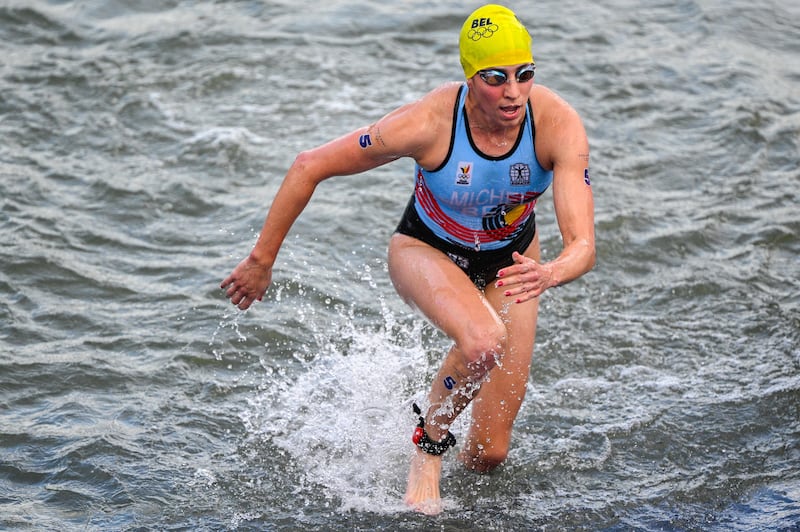Ask yourself, would you swim in the river Seine? Visually, it looked much like the river Liffey does from O’Connell, Bridge. Peering down at the start/finish point for the 10km marathon race at Pont Alexandre III last Friday, the water varied in colour from green to brown depending on how the light hit the surface.
Paris may have broken the mould by immersing the Olympic Games in the city and providing broadcasters with stunning backdrops for a variety of sports but the plan to run events in a river that takes whatever run-off the city sends down seems now like a risk-reward decision made by the organisers. And the health of the athletes was the risk.
The water in the Seine was under question from long before the games began, with swimming banned there since 1923 before a recent €1.4 billion cleaning operation.
Irish double Olympic medallist Daniel Wiffen was the latest athlete to fall foul, as he tweeted on Monday: “Yesterday I rushed to hospital as I was very unwell with a bug that I am being treated for and am feeling better now.”
READ MORE
The Tweet arrived at 2.56am on August 12th. His 18th place in the 10km swim was achieved on August 9th. Ireland’s first swimming gold medal winner in three decades began to feel unwell a little more than 24 hours after his 1:57:20.1 immersion in the Paris’s fabled river.
At Monday’s Olympic homecoming in Dublin Wiffen confirmed it was the river swim that had made him sick and prevented him from fulfilling his role as flag bearer in Stade de France at the closing ceremony.
Speaking to Cool FM, Wiffen said: “I’m okay. I was a bit ill for the past couple of days from the river Seine, but I’m starting to recover now and it’s gone through my system, so I’m looking forward to this.”
Wiffen was not the only casualty. On Tuesday, August 6th, a test run in the river to allow Olympic athletes to familiarise themselves with the marathon course was cancelled over concerns about water quality.

World Aquatics released a statement saying it had made the decision to cancel the run at an early-morning meeting due to fluctuating bacteria levels. Predictably, E.coli and enterococci were the main two culprits.
Guidelines on water quality from World Aquatics and World Triathlon says that “good” water can include up to 1,000 colony-forming units of E.coli per 100ml and up to 400 colony-forming units of enterococci per 100ml. With numbers apparently within the guidelines the marathon 10km took place as planned, starting at 7.30am.
However, data provided courtesy of the Fluidion Open Data initiative showed more problematic readings. Fluidion monitors water quality for “government agencies, international organisations, academic institutions and private sector companies worldwide.”
It is an independent French company with no affiliations to Paris or the 2024 Olympic committee. Self-funded, it monitored the river water before and during the Olympic Games.
Its scientists took samples at 7.30am, 8.30am, 9am, and 9.30am on August 9th – the day of Wiffen’s river swim – and found comprehensive counts of bacteria indicating degraded water quality, with measurements of 867, 4,132, 1,338, and 650. Two of the samples exceeded the safety number, “with a peak of contamination occurring shortly after the event began”.

The company concluded: “The geometric mean for all samples collected during the event was 386 E.coli/100ml (planktonic) and 1,329 E.coli/100ml (comprehensive), indicating that the water quality remained in a risk-prone ‘grey zone’. The water was contaminated with fecal E.coli-rich particles at certain points, reaching levels up to four times the World Triathlon threshold. Congratulations to the athletes who competed, and let’s hope that everybody stays healthy!!!”
Wiffen was not the only casualty of the Seine. Four triathletes from the men’s and women’s races fell sick, including Claire Michel from Belgium, prompting Belgium’s Olympic committee to withdraw its team from the mixed-relay triathlon, although it wasn’t clear whether her illness had anything to do with the water.
It is not an issue of the readings given by the organisers differing with those given by an independent body, although that is curious, but why the athletes were asked to swim in the river in the first place. The answer is obvious. The Eiffel Tower on one side and the Grand Palais on the other with the 107m-tall golden dome of Les Invalides out there looking beautiful like the rest of the cityscape.
But one of the fundamental principles of the Olympic charter is that the Olympic Games “assemble amateurs of all nations in fair and equal competition under conditions which are as perfect as possible.” A river alive with bacteria – perfect? No, but it did allow Paris to look stunning.















